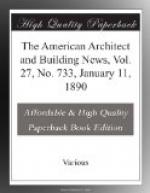Some years after peace was restored, the Verplanck family appear to have occupied the Homestead from time to time. Philip Verplanck, a grandson of Gulian the original grantee, was a native of the patent, but his public life was spent elsewhere. He was an engineer and surveyor, and an able man. Verplanck’s Point in Westchester County, where Fort Lafayette stood during the Revolution, was named for him, and he represented that Manor in the Colonial Assembly from 1734 to 1768. Finally, Daniel Crommelin Verplanck with his large family—one of his sons being the well-known Gulian C. Verplanck, born here in 1786—came to live in the old home permanently. He had led an active life in New York, served in Congress and on the bench, and now retired to the quiet of the country. It was he who planted the fine old trees which now shade the lawn; among them the coffee-tree so much admired. About 1810 the north end, built of wood, was added to the old house. Architects were not numerous, apparently, in those days, so the Dutch type was lost in making this large addition, though the interior is quaint, dignified and interesting. It was from under its roof that Daniel C. Verplanck was carried to his last resting-place as his father before him, and generations after him lived and still live in the old Homestead.
For the above description, prepared with no little painstaking, of an interesting house and demesne, as well as for the loan of the photograph from which I made my pen-and-ink sketch of it, I am wholly indebted to a member of the Verplanck family and a mutual friend.
A.J. BLOOR.
* * * * *
ROCK UPHEAVAL CAUSED BY HYDRAULIC PRESSURE.—There was a remarkable occurrence at the mills of the Combined Locks Paper Company at Combined Locks, Wis., on Saturday. From some unknown cause there was an upheaval of rock upon which the mills are located, throwing the mill walls out of place, cracking a great wall of stone and cement twenty feet thick and making a saddle-back several hundred feet long and six inches high in the bed rock beneath the mill. An artesian well two hundred feet away on the bluff has dried up. The damage to the mill and machinery will probably amount to several thousand dollars. The upheaval is supposed to have resulted from some hydraulic pressure between the seams of rock beneath. A panic occurred among the mill operatives at the time of the shake-up, but nobody was hurt in the stampede from the mill.—Boston Transcript, September 10.
ELECTRICITY’S VICTIMS IN EUROPE.
[Illustration: Monument to Minine and Pojarsky, Russia.]
Although the greatest number of deaths from electricity have occurred in this country—more than one hundred—of which twenty-two occurred in this city, yet other countries have not been without such “accidents,” as has been erroneously stated by experts in the employ of the companies interested in the deadly high-voltage currents, and as the subjoined list, compiled by C.F. Heinrichs, the electrical expert, shows. The list is by no means exhaustive. Many European newspapers contain articles advising stringent measures to stop the causes of those accidents and the use of currents of electricity above six hundred volts.




